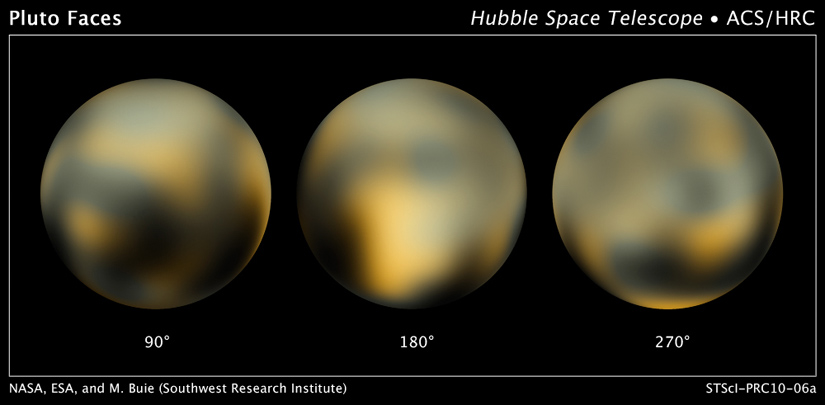Pluto has an atmosphere? Shocking, right?
It may not have official planetary status, but the dwarf planet does have an atmosphere. In fact, it's the only dwarf planet with a known atmosphere. What's more, it has just been announced that its atmosphere reaches nearly one quarter of the way to Pluto's largest moon Charon and swept back -- like a cometary tail -- by the weak pressure of the solar wind.
Comment: Pluto's atmosphere is "like a cometary tail" because it is a cometary tail. All objects within the solar system discharge the solar capacitor in the method described here. According to James McCanney's model, comets acquire an atmosphere as they discharge, attracting positive ions to the anti-sunward side of the body and forming the comet coma (in small comets) or atmosphere (in large comets, like Pluto).
But before you start getting excited about breathing Plutonian air in the future, Pluto's atmosphere is very thin. And besides, it's composed of a poisonous gas. Calling it an "atmosphere" is a little on the generous side, but it's there (albeit tenuous), and astronomers have taken some fascinating measurements of it.
Speaking at the UK's Royal Astronomical Society's National Astronomy Meeting on Wednesday, Jane Greaves from the University of St Andrews presented her team's discovery of an extended carbon monoxide (CO) atmosphere.
The CO -- a gas that is poisonous to humans -- was detected using the 15-meter James Clerk Maxwell Telescope in Hawaii, extending the height of Pluto's known atmosphere from around 100 kilometers (62 miles) thick to over 3,000 kilometers (1,860 miles) thick.
So, Pluto has a more extended atmosphere than we thought. But that's not the only interesting thing. The dwarf planet's atmosphere is changing.
In 2000, another Pluto observing team used the Spanish IRAM 30-meter telescope and didn't detect CO, so their observations put a lower limit on the concentration of atmospheric CO.
"The change in brightness over the last decade is startling," Greaves said. "We think the atmosphere may have grown in size, or the carbon monoxide abundance may have been boosted."
Dynamic changes in the Plutonian atmosphere have been detected before, but the changes occurred at low altitudes in methane abundances near the surface. These changes in methane are thought to be linked with Pluto's 1989 closest approach to the sun in its orbit.
Although the dwarf planet is now moving away again, perhaps this increased abundance of CO is down to Pluto's south pole recently coming out of shadow for the first time in 120 years. Perhaps the south pole is evaporating faster than the north pole is condensing, outgassing a surplus of CO into the atmosphere.
But more exciting than seeing changes in the Plutonian atmosphere is its possible shape.
When analyzing the spectrum of the light reflected from this extended CO atmosphere, Greaves' team spotted something odd. There's a slight redshift in wavelength, indicating that the bulk of the gas is moving away from the Earth. Although the results are preliminary, Greaves has a theory.
"The marginal CO line red-shift, if real, could indicate a flow forming into a comet-like tail directed away from the Sun," she said.
Comment: Or it could be a result of induced electric dipole redshift, predicted by McCanney.
Even though Pluto patrols the outermost region of the solar system, even this little world isn't immune to the ravages of the solar wind, potentially turning it into a "comet dwarf."
Comment: Again, it's not just the solar wind, it's the discharge caused by the excess positive charge of the solar wind.
"Seeing such an example of extra-terrestrial climate-change is fascinating", said Greaves. "This cold simple atmosphere that is strongly driven by the heat from the Sun could give us important clues to how some of the basic physics works, and act as a contrasting test-bed to help us better understand the Earth's atmosphere."
Sources: NAM2011, arXiv blog





Methane......so they keep telling us then Crude comes from fossils!!